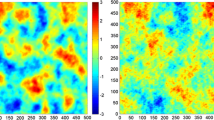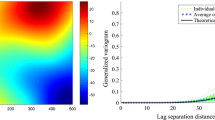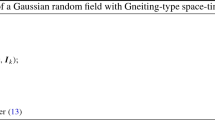Abstract
This paper addresses the problem of simulating multivariate random fields with stationary Gaussian increments in a d-dimensional Euclidean space. To this end, one considers a spectral turning-bands algorithm, in which the simulated field is a mixture of basic random fields made of weighted cosine waves associated with random frequencies and random phases. The weights depend on the spectral density of the direct and cross variogram matrices of the desired random field for the specified frequencies. The algorithm is applied to synthetic examples corresponding to different spatial correlation models. The properties of these models and of the algorithm are discussed, highlighting its computational efficiency, accuracy and versatility.




Similar content being viewed by others
References
Albeverio S, Jorgensen PET, Paolucci AM (2012) On fractional Brownian motion and wavelets. Complex Anal Oper Theory 6:33–63
Amblard PO, Coeurjolly JF, Lavancier F, Philippe A (2013) Basic properties of the multivariate fractional Brownian motion. Séminaires et Congrès 28:65–87
Arakawa K, Krotkov E (1994) Modeling of natural terrain based on fractal geometry. Syst Comput Jpn 25(11):99–113
Arroyo D, Emery X (2015) Simulation of intrinsic random fields of order k with Gaussian generalized increments by Gibbs sampling. Math Geosci 47(8):955–974
Asmussen S, Taksar M (1997) Controlled diffusion models for optimal dividend pay-out. Insur Math Econ 20(1):1–15
Asmussen S (1998) Stochastic simulation with a view towards stochastic processes. University of Aarhus, Centre for Mathematical Physics and Stochastics
Beran J (1994) Statistics for long-memory processes. Chapman and Hall, London
Chen CC, Daponte J, Fox M (1989) Fractal feature analysis and classification in medical imaging. IEEE Trans Med Imaging 8:133–142
Chi M, Neal E, Young GK (1973) Practical application of fractional brownian-motion and noise to synthetic hydrology. Water Resour Res 9(6):1523–1533
Chilès JP (1995) Quelques méthodes de simulations de fonctions aléatoires intrinsèques. In Cahiers de Géostatistique 5, Paris School of Mines, pp 97–112
Chilès JP, Delfiner P (2012) Geostatistics: modeling spatial uncertainty, 2nd edn. John Wiley & Sons, New York
Coeurjolly JF (2000) Simulation and identification of the fractional Brownian motion: a bibliographical and comparative study. J Stat Softw 5(7):1–53
Collins JJ, De Luca CJ (1994) Upright, correlated random walks: a statistical-biomechanics approach to the human postural control system. Chaos 5(1):57–63
Combes JM, Grossmann A, Tchmitchian PH (1989) Wavelets. Springer, New York
Comegna A, Coppola A, Comegna V, Sommella A, Vitale CD (2013) Use of a fractional brownian motion model to mimic spatial horizontal variation of soil physical and hydraulic properties displaying a power-law variogram. Proc Environ Sci 19:416–425
Dale MRT, Mah M (1998) The use of wavelets for spatial pattern analysis in ecology. J Veg Sci 9:805–814
Danudirdjo D, Hirose A (2011) Synthesis of two-dimensional fractional Brownian motion via circulant embedding. In 18th IEEE International Conference on Image Processing, pp 1085–1088
Emery X, Arroyo D, Porcu E (2016) An improved spectral turning-bands algorithm for simulating stationary vector Gaussian random fields. Stoch Environ Res Risk Assess, 1–11
Emery X (2008) Statistical tests for validating geostatistical simulation algorithms. Comput Geosci 34(11):1610–1620
Emery X, Lantuéjoul C (2006) TBSIM: a computer program for conditional simulation of three-dimensional Gaussian random fields via the turning bands method. Comput Geosci 32(10):1615–1628
Emery X, Lantuéjoul C (2008) A spectral approach to simulating intrinsic random fields with power and spline generalized covariances. Comput Geosci 12(1):121–132
Flandrin P (1989) On the spectrum of fractional Brownian motion. IEEE Trans Inf Theory 35:197–199
Flandrin P (1992) Wavelet analysis and synthesis of fractional Brownian motion. IEEE Trans Inf Theory 38(2):910–917
Fournier A, Fusell D, Carpenter RL (1982) Computer rendering of stochastic models. Graph Image Process 25(6):371–384
Herzfeld UC (1993) Fractals in geosciences: challenges and concerns. Computers in geology: 25 years of progress. Oxford University Press, New York, pp 176–230
Horn RA, Johnson CR (1985) Matrix analysis. Cambridge University Press, Cambridge
Huang J, Turcotte DL (1989) Fractal map** of digitized images: application to the topography of Arizona and comparisons with synthetic images. J Geophys Res 94:7491–7495
Jensen OG, Todoeschuk JP, Crossley DJ, Gregotski M (1991) Fractal linear models of geophysical processes. In: Schertzer D, Lovejoy S (eds) Non-linear variability in geophysics, scaling and fractals. Kluwer Academic, Dordrecht, pp 227–239
Lantuéjoul C (1994) Non conditional simulation of stationary isotropic multigaussian random functions. In: Armstrong M, Dowd PA (eds) Geostatistical simulations. Kluwer Academic, Dordrecht, pp 147–177
Lantuéjoul C (2002) Geostatistical simulation: models and algorithms. Springer, Berlin
Malinverno A (1995) Fractals and ocean floor topography: a review and a model. In: Barton CC, La Pointe PR (eds) Fractals in the earth sciences. Springer, New York, pp 107–130
Mandelbrot BB (1982) The fractal geometry of nature. Freeman, San Francisco
Mantoglou A (1987) Digital simulation of multivariate two- and three-dimensional stochastic processes with a spectral turning bands method. Math Geol 19(2):129–149
Matheron G (1973) The intrinsic random functions and their applications. Adv Appl Probab 5:439–468
Michna Z (1999) On tail probabilities and first passage times for fractional Brownian motion. Math Methods Oper Res 49:335–354
Molz FJ, Rajaram H, Lu S (2004) Stochastic fractal-based models of heterogeneity in subsurface hydrology: origins, applications, limitations, and future research questions. Rev Geophys 42(1):1–42
Ott WR (1981) A Brownian motion model of pollutant concentration distributions. Department of Statistics and SIAM Institute for Mathematics and Society, Stanford University, p 57
Palmer MW (1992) The coexistence of species in fractal landscapes. Am Nat 139:375–397
Peitgen HO, Saupe D (1988) The science of fractal images. Springer, New York
Pipiras V (2005) Wavelet-based simulation of fractional Brownian motion revisited. Appl Comput Harmonic Anal 19(1):49–60
Pozdnyakov V, Meyer T, Wang YB, Yan J (2014) On modeling animal movements using Brownian motion with measurement error. Ecology 95(2):247–253
Romanow AL (1984) A Brownian motion model for decision making. J Math Sociol 10:1–28
Shinozuka M (1971) Simulation of multivariate and multidimensional random processes. J Acoust Soc Am 49(1B):357–367
Smith WT (1994) Investment, uncertainty and price stabilization schemes. J Econ Dyn Control 18:561–579
Stein ML (2002) Fast and exact simulation of fractional Brownian surfaces. J Comput Graph Stat 11(3):587–599
Turcotte DL (1986) A fractal model for crustal deformation. Tectonophysics 132:261–269
Turcotte DL (1997) Fractals and chaos in geology and geophysics, 2nd edn. Cambridge University Press, New York
Voss RF (1985) Random fractal forgeries. In Earnshaw R.A. (ed.) Springer, Berlin, 805–835
Walker JS (1997) Fourier analysis and wavelet analysis. Notices AMS 44(6):658–670
Willinger W, Taqqu MS, Leland WE, Wilson DV (1995) Self-similarity in high-speed packet traffic: analysis and modeling of Ethernet traffic measurements. Stat Sci 10(1):67–85
Acknowledgments
The authors acknowledge the funding by the Chilean Commission for Scientific and Technological Research, through Projects CONICYT / FONDECYT / POSTDOCTORADO / N\(^{\circ }\)3140568, CONICYT / FONDECYT / REGULAR / N\(^{\circ }\)1130085 and CONICYT PIA Anillo ACT1407. Constructive comments from two anonymous reviewers helped to improve the manuscript.
Author information
Authors and Affiliations
Corresponding author
Appendices
Appendix 1: Covariance and variogram
Consider a scalar intrinsic random field \(Y=\{Y(\mathbf {x}):\mathbf {x}\in \mathbb {R}^d\}\) and denote by \(\gamma (\mathbf {h})\) its variogram for the separation vector \(\mathbf {h}\). For given locations \(\mathbf {x}\), \(\mathbf {x}'\) and \(\mathbf {x}_0\), let us express the covariance between the two increments \(Y(\mathbf {x}) - Y(\mathbf {x}_0)\) and \(Y(\mathbf {x}') - Y(\mathbf {x}_0)\) in terms of the variogram:
Accordingly:
Note that this covariance is unchanged by shifting the locations \(\mathbf {x}\), \(\mathbf {x}'\) and \(\mathbf {x}_0\) by a given vector \(\mathbf {h}\), i.e., \(C(\mathbf {x}, \mathbf {x}^{\prime}, \mathbf {x}_0) = C(\mathbf {x}+\mathbf {h}, \mathbf {x}^{\prime}+\mathbf {h}, \mathbf {x}_0+\mathbf {h})\), showing that the intrinsic random field has second-order stationary increments. Furthermore, by taking \(\mathbf {x}_0 = \mathbf {0}\) and considering that \(Y(\mathbf {0}) = 0\), it ensues:
which shows that the knowledge of the variogram is equivalent to that of the covariance function of the random field.
Appendix 2: Existence conditions for Example 1
The spectral density matrix \(\mathbf {f}(\mathbf {u})\) defined in Eq. (10) is Hermitian because it is a real symmetric matrix. To check that it is positive semi-definite, one therefore only needs to verify that its determinant is non-negative (Horn and Johnson 1985), that is:
that is:
From this inequality to hold, one first needs to verify the following:
If \(2\theta _{12}<\theta _1+\theta _2\), inequality (14) is not satisfied for \(\Vert \mathbf {u}\Vert >1\), whereas if \(2\theta _{12}>\theta _1+\theta _2\), inequality (14) is not satisfied for \(\Vert \mathbf {u}\Vert <1\). Therefore, one must have
in which case Eq. (14) obviously holds \(\forall \mathbf {u}\in \mathbb {R}^d\). Under this condition, one obtains from Eq. (13):
Appendix 3: Existence conditions for Example 2
The spectral density matrix \(\mathbf {f}(\mathbf {u})\) defined in Eq. (12) is Hermitian positive semi-definite if its determinant is non-negative, i.e.:
that is:
with
The map** \(\varphi :\mathbb {R}_+\rightarrow \mathbb {R}\) is unbounded if \(\theta _1+\theta _2>4\nu _{12}\), in which case inequality (15) cannot be satisfied. In the converse \((\theta _1+\theta _2\le 4\nu _{12})\), the maximum of \(\varphi \) is found to be
Therefore, for the spectral density matrix \(\mathbf {f}(\mathbf {u})\) to be positive semi-definite for all \(\mathbf {u}\in \mathbb {R}^d\), the following necessary and sufficient conditions must be fulfilled:
and
In the particular case when \(\theta _1+\theta _2=4\nu _{12}\), then \(\varphi _{\max }=(2\pi a_{12})^{-(\theta _1+\theta _2)}\), and the limit value for \(|\rho|\) is given by
Rights and permissions
About this article
Cite this article
Arroyo, D., Emery, X. Spectral simulation of vector random fields with stationary Gaussian increments in d-dimensional Euclidean spaces. Stoch Environ Res Risk Assess 31, 1583–1592 (2017). https://doi.org/10.1007/s00477-016-1225-7
Published:
Issue Date:
DOI: https://doi.org/10.1007/s00477-016-1225-7




